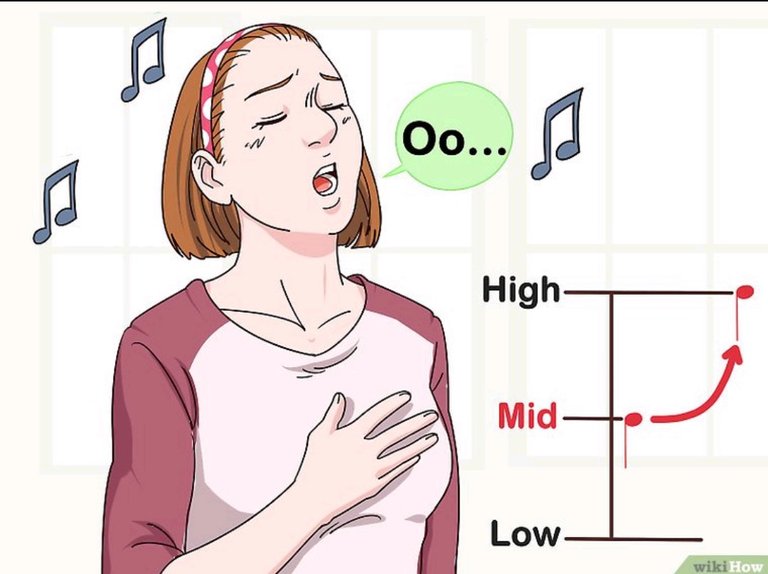HOW TO SING HIGH NOTES
Every singer wants to increase their vocal range, and hitting high notes is the most impressive feat of all. No one is born being able to sing the highest notes perfectly, though! Vocal cords need exercise, just like other muscles, to get stronger. Start by learning how to relax your muscles. Then get your voice warmed up and practice specific exercises to help you increase your range.
Part One of Three:
Relaxing Your Muscles
-1
- Take slow, relaxed breaths to release tension. Your breathing needs to be relaxed to hit high notes. Otherwise, that tension goes right into your voice. Take a normal breath in, then exhale. Keep your breath slow and even.
- Relax your shoulders, neck and chest as you continue to breathe in and out. This helps release tension from those areas.[1]
-2
- Massage your face and jaw muscles to release jaw tension. Put the heels of your hands on either side of your face, right below your cheekbones. Push them gently into your cheeks, then move them slowly down into your jaws. Let your mouth hang open a little bit. Repeat this several times.[2]
-3
Do some neck and shoulder rolls to loosen up the muscles. Slowly roll your neck from side to side. Once your neck feels stretched out, roll your shoulders gently and slowly, backward and forward. Then let your arms hang loosely at your sides.[3]
Try to keep your arms loose as you practice. Avoid the urge to ball up your fists or strain your arm muscles when trying to hit high notes.
Part Two of Three:
Warming up Your Voice
-1
Drink a glass of warm water to relax throat muscles. It also helps hydrate the vocal chords, allowing you to reach the higher registers. Add honey to your water to decrease and/or prevent their throat from swelling.[4]
Don't drink ice water, caffeine or milk before warming up your voice. These can have a negative effect on your singing voice.
2
Trill with your lips to warm them up. Press your lips together loosely. Release air through your mouth in a steady stream, so that your lips vibrate and make a raspberry sound. Move on to doing this with “h” sounds, maintaining a steady voice as you move the air past your lips.
Once you’ve got that, try it on “b” sounds. Then continue doing “b” sounds, but go up and down the scales.[5]
3
Stretch out your vocal chords with “sirens.” Round your mouth into an “o” position and inhale. It helps to imagine you’re sucking down a spaghetti noodle! When you exhale, make a “woo” sound. Keep your “woo” steady and repeat this 2-3 more times.
After that, start going up and down the scales as you “woo.”[6]
4
Do two octave scales to warm up for higher notes. Starting in a low pitch, sing a “me” sound as you go up the scale. Reverse and go down the scale as you sing an “ee” sound. Keep going, up and down, gently increasing your range each time.
Once you’re feeling pretty loose, switch to an “oo” sound and repeat.[7]
- During warm up, don't push your voice to go higher than what’s comfortable for you. This can actually decrease your range over time.[8]
Part Three of Three:
Developing Your Range
1
Breathe from your abdomen for a stronger sound. As a singer, you’ve probably heard this advice countless times. It’s important, though! It helps you hit and maintain high notes, and helps to relax your muscles.[9]
When you inhale, your stomach should rise first, followed by your chest.
If you have trouble with this, try putting your hand on your abdomen as you breathe. It’ll remind you to focus on breathing from that area.
2
Start in the middle of your range and sing higher and higher. This can be a continuation of the “oo” and “ee” sounds you used in warm-up. Once you get your voice up into the high register that you want, open up those vowel sounds to sound more like “oh” and “uh.”[10]
As you practice this over time, you’ll notice that the higher notes are getting easier and easier to reach.
3
Experiment with your vowel sounds. Each voice has certain vowels that work best when singing high notes. Others are harder to hit. You should experiment to determine which vowels work and sound best for you. Once you have an idea of which vowel works best, modify (gradually) towards that vowel as you ascend the scale.
For example, you might have a hard time hitting a long "e" (like in "meet"), but you can easily hit a short "i." You could modify the long "e" in "meet" by singing "mitt" and subtly adjusting the "i" into the long "e" as you get higher.[11]
4
Start putting a consonant in front of vowels. Consonants, like a hard “g,” can help you get better at cord closure. After practicing vowels for a while, put a hard “g” in front of them. This helps you maintain a steady sound by keeping your vocal cords vibrating steadily.[12]
Also work on consonants like “m” and “n” in front of vowels.
Cord closure is when your vocal cords come together to create a sound. If they aren’t “closed” all the way, it's difficult to maintain steady air flow.[13]
5
Sing the word "yawn" on the high notes to get your mouth in position. When rehearsing, never hesitate to sing the word "yawn" for one of those notes in your upper range. When you sing that word, it positions your mouth and throat in exactly the right place to hit high notes. This is a handy trick to help you get used to the proper mouth positioning; don't do this during a performance, though!
6
Keep your sounds smooth and connected. Steady airflow allows you to hit and maintain your high notes. As you work on your range, keep your breath flowing in and out steadily. Strive to make smooth, connected sounds.[14]
Think about the whole phrase that includes the high note, then support your voice continuously from the beginning. This connects the high note to the notes before it.
Forcing out air on certain notes can strain your throat and voice.
7
Cool down after each session to prevent injury. Working on high notes is hard on your vocal cords. To keep those muscles operating well, cool them down after you work them out. To do this, hum gently while making an “m” sound. Move up and down the scales as you make the “m” sound.[15]
Focus on how the sound feels coming out of your lips. It will vibrate and tickle a little bit!
SOME COMMON Q&A
- Are you allowed to eat cold foods before singing/ vocal warm ups?
Answer|
The most important thing is that your throat does not feel dry. Thus, having something to drink before singing is useful. Most singers prefer something lukewarm, preferably of not alcoholic nature. Tea or warm herbal drinks are often ideal.
What if your voice cracks? Will you still be able to get to the note eventually?
Answer|
If you look downwards while singing a high note, it prevents voice cracks, in most cases. If you keep practicing looking down, raising your face higher every time, you will get to the high note without your voice cracking. If this doesn't help, don't worry. You will get it eventually if you keep practicing.
I am 74 and can sing everything except some high notes. What can I do to improve my range?
Answer|
Try strengthening your lungs as much as you can. Different postures and body positions can help you find the higher notes too, so do some fitness exercises to stay lithe and strong, Every important.
How do you prevent yourself from straining while you do the high notes?
Answer|
Try vowel modification. some vowels like ee and oo are easier to sing higher. Modify words just a little, like singing loove instead of love. It will still be understood in context. Listen to pop singers who can sing high, and how they modify their vowels. Unless you listen, you often don't notice right away. Also try singing high notes through your nose more than through your chest, as if you were using a "Julia Child" voice but not as drastic.
I've been trying to hit the high note in Adele's song hello but I can't do it. Any ideas?
Answer|
Practice the song slowly before singing the note outright. The buildup to the note is the most important bit to rehearse as once you have sung it lots, you can focus on the note that really matters. However, if your voice cannot hit high notes, then be realistic.
Will smoking cigarettes harm my vocal cords?
Answer|
Yes. All the chemicals that are normally harmful to your lungs are even worse for your vocal chords. Smoking is bad for your whole body.
What do I do if I'm sitting down when I'm singing?
Answer|
Sit up straight and fix your upper body's posture to be as if you were standing. Move your butt to the edge of your seat, as this will help force you into a straighter posture. Sing some vowels preceded by H (ho, ha, heh) to feel your gut pump and to ensure you can retain power similar to when you're standing.
Can a man also hit high notes?
Answer|
Lol.. Yes, men can also sing high notes almost as easily as women. When practiced and frequently used, men have a tone of voice used especially for higher notes called a falsetto. It may not always be as strong as you would like but the more you try to use it, the more it can improve.
How do I get ready for singing high notes?
Answer|
- Normally vocal warm ups are a must before any type of performance, but make sure you don't strain your voice. Try singing up and down scales with different exercises that are comfortable to you and are in the vocal range of the piece you are about to perform.
Hope this help to all upcoming artist. Also Images are provided below for more clearity.
@MattDeBaritone
#WikiHow.com!













